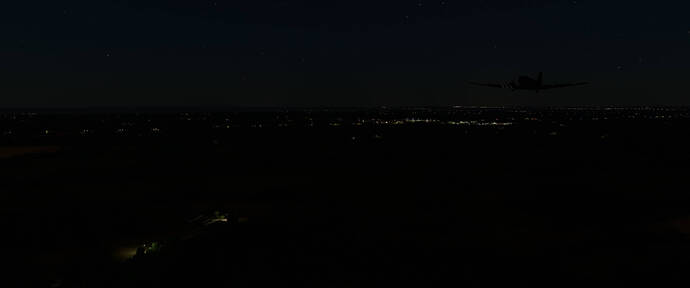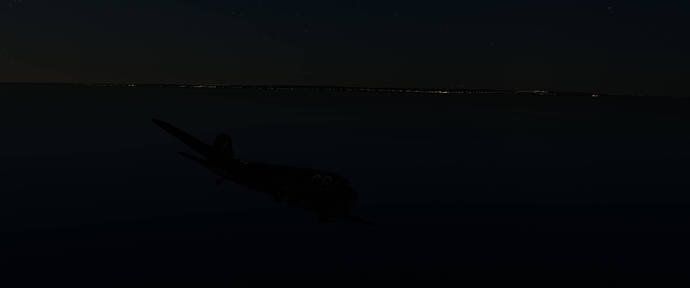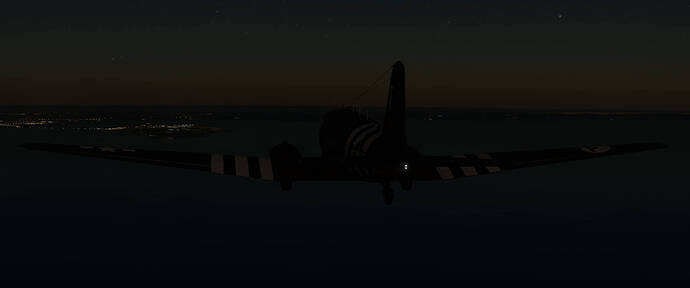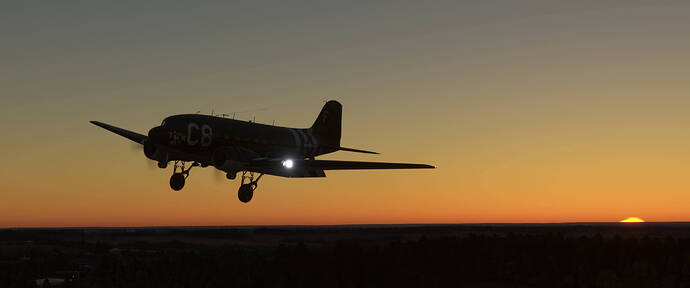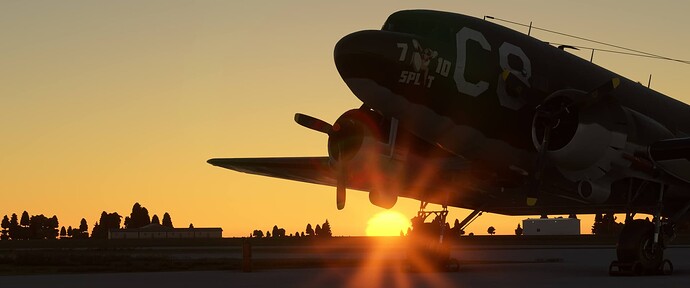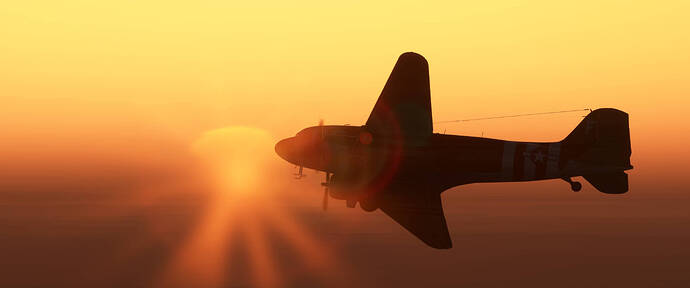![]() 2:28 a.m. (10 Minutes to Green Light)
2:28 a.m. (10 Minutes to Green Light)
Pee-Wee says: The 52nd Troop Carrier Squadron has been over France for less than sixty seconds, and already the plan is coming unglued. Flying at 1,500 feet (460 meters) over the Norman coast, Serial 25, including all eighteen of the squadron’s aircraft, has plunged into a cloudbank just north of Barneville-Carteret. The pilots are suddenly thrown into solid Instrument Meteorological Conditions and must transition instantly–and unexpectedly–to flying on instruments.
Captain Mayfield in 7-10 Split focuses on his attitude indicator and asks his copilot what he sees out the windscreen. Crocker leans forward until his nose nearly touches the glass and looks intently toward where Captain Finucan’s The Nomad had been only seconds before. He barely makes out the white stripes painted on the C-47’s fuselage and wings and says, “I’ve still got 'em…barely.”
For several seconds the two pilots work together to maintain control of the aircraft and their position in formation. Finucan is slowly climbing, apparently hoping to get above the clouds.
Regardless of their training, experience, or courage, in 1944 there is simply no means for Troop Carrier pilots to maintain closely spaced formations at night in the clouds. Collisions are now the greatest threat to the mission, and Serial 25’s rear element scatters.
Mayfield in 7-10 Split and Taylor in Bethany Jo manage to stay with Finucan. Weber in Sack Time Sally drifts to the right, with Suddery in Fair Victoria hanging on by his fingernails. Christman in Chalk 68 loses his leader completely and climbs away to the right. Daniels in Witch Craft doesn’t see Finucan climb and leads Wilson in Hi-De-Ho up and away to the left. Zimmerling’s Snake Pit is alone near the cloud tops and drifting north.
Pee-Wee says: A bead of sweat rolls down Mayfield’s face, and he thinks to himself "now this is like Sicily."
![]() 2:33 a.m. (5 Minutes to Green Light)
2:33 a.m. (5 Minutes to Green Light)
Pee-Wee says: After only three minutes (the Troop Carrier pilots would swear it was an hour), the broken formation finds clear skies again west of Saint-Jacques-de-Néhou, but the damage is done: only five airplanes in Serial 25’s rear element are still together. Daniels and Wilson are slightly north of the formation and trying to rejoin. Zimmerling is close behind but can’t find his flight leader in the dark and struggles to see a useful landmark below. Still above the clouds and heading south, Christman will be lucky to find France.
The 82nd’s Pathfinders were only partially successful. Those destined for Drop Zone O landed on target and deployed their Eureka radio beacon and lights. The second team landed off target and never reached Drop Zone N. The third team landed precisely on Drop Zone T and, while they were able to deploy the Eureka and BUPS beacons there, the close proximity of German soldiers prevented them from showing the red-lighted “T.” Mission Boston’s success now depends heavily on the ability of the Troop Carrier pilots to navigate accurately to an almost featureless point in unfamiliar territory at night while being shot at.
The route to the drop zones avoids known anti-aircraft artillery concentrations, but in occupied France every German with a gun is a flak battery. The skies ahead are alight with gunfire, mostly small caliber and dangerous only in the case of “lucky shots.” Regardless, many pilots, crewmen, and paratroops are wounded by bullets piercing the bottoms of their planes.
Pee-Wee says: A machine gun burst rakes across The Nomad. Within seconds her right engine is aflame, and Mayfield and Taylor back away. The sixteen paratroops jump clear before the mortally wounded C-47 descends out of view to the right. There is no time for shock or mourning: Captain Mayfield is leading now and Drop Zone T lies somewhere in the confused darkness only a few miles ahead.
![]() 2:35 a.m. (3 Minutes to Green Light)
2:35 a.m. (3 Minutes to Green Light)
Pee-Wee says: Mayfield slows to drop speed, 110 miles per hour (95 knots, 177 kilometers per hour). Up ahead the Merderet glistens in the full moon’s light. Mayfield flashes the red signal light.
Lieutenant McGuire: “Two minutes!”
By now German soldiers in the immediate vicinity know where the drop zones are located and from which direction the C-47s will approach. Anti-aircraft fire increases in intensity and accuracy, yet the formation flies straight and level through the maelstrom. Landing the paratroops on target is the only thing that matters now. As stated in the 73rd’s Field Order:
“Pilots of aircraft will be held responsible for the delivery of paratroop loads to the DZ’s. Evasive action prior to delivery of troops will not be tolerated.”
Pee-Wee says: The river bend slips out of sight beneath 7-10 Split’s nose, and Mayfield scans one last time: 700 hundred feet, 110 miles per hour, jump attitude, wings level, and no other aircraft approaching. He turns on the green signal.
![]() 2:38 a.m. (Green Light)
2:38 a.m. (Green Light)
Pee-Wee says: Sergeant Wahl mashes the salvo switch near the jump door and releases the six parapacks from 7-10 Split’s belly.
Lieutenant McGuire: “Let’s go!”
Second Platoon shuffles out the door and Mayfield pushes forward on the yoke to maintain jump attitude. Within fifteen seconds the paratroops are swinging safely under their canopies, and the 52nd’s C-47s, relieved of 5,400 pounds (2,450 kilograms) of men and equipment, lunge upward and forward.
Mayfield looks left and waits for the last of Bethany Jo’s paratroops to jump, then pushes 7-10 Split’s nose down and accelerates toward Utah Beach and the relative safety of the English Channel. Their mission accomplished, the crews of the 52nd are on their own now.
But they’re not out of danger yet. Some crews in the preceding serials miss their drop zones completely and, upon encountering the Cherbourg Peninsula’s eastern shore, turn around for another pass. Crews of the 73rd TCG are instructed to execute a right turn at the shoreline and deposit their paratroops on Drop Zone D near Carentan, a maneuver that will separate them from the oncoming stream of airplanes. But not every crew knows its exact location or can find Drop Zone D. The threat of midair collisions arises again.
Pee-Wee says: Sergeant Wahl draws the fifteen static lines back into the airplane and begins securing the cabin. Sergeant Pennypacker, who had been standing behind the pilots ready to assist in the event one was wounded, comes back to help. They both check the cabin for damage.
The formation heads over the water to a point near Îles Saint-Marcouf then turns north toward SPOKANE approximately nine miles east-northeast of the Pharre de Gatteville. Again, the lessons of the Mediterranean are applied: aircraft returning from Missions Albany and Boston fly only 100 feet (30 meters) above the water through a 10-mile (16 kilometer) wide “safe” corridor off the Cherbourg Peninsula’s east coast, and the Allied ships anchoring offshore are warned to not shoot.
7-10 Split passes just west of one of those ships, the American destroyer Corry (DD-463). In only four hours, Corry will fall victim to the heavy guns of Battery Crisbecq near Saint-Marcouf, becoming the largest US Navy casualty of D-Day.
Pee-Wee says: Sergeant Wahl has found everything in order, but there’s a trail of blood running across the floor and out the door. It seems one of the paratroops was wounded but jumped anyway.
In the cockpit, the two pilots are still fully occupied. Mayfield is concentrating on maintaining altitude, heading, and airspeed. Crocker divides his time between the altimeter and checking the time to SPOKANE, where the formation will turn west around Cherbourg. Both men occasionally scan the skies ahead for other aircraft, but see only wave flickering in the moonlight.
![]() SPOKANE: 2:50 a.m. (12 Minutes After Green Light)
SPOKANE: 2:50 a.m. (12 Minutes After Green Light)
That’s Barfleur and Gatteville-le-Phare in the distance. The Pharre de Gatteville lighthouse, the second tallest in France, stands to the right. The Germans there are mostly unaware of what is happening on the Peninsula but will flee toward Cherbourg as the 4th Infantry Division approaches in a few days. The Locals will convince the German occupiers to spare the light. It’s open to public tours today.
Every formation turns west at SPOKANE and heads toward the Eureka-equipped ship at GALLUP. Those without navigators rely on pilotage to remain inside the safe corridor. Many damaged aircraft and those with wounded abord short circuit the route here and head straight toward the emergency landing field at RAF Warmwell.
Scattered and battered, Serial 26 drops the final 82nd Airborne paratroops over Drop Zone T, and both Divisions are fully committed to the battle. The fifty glider-towing C-47s of Mission Chicago are passing FLATBUSH with infantryman of the 101st Airborne destined for landing zones south of Sainte-Mère-Église, and the 82nd’s fifty-two gliders are ten minutes behind.
Only a few minutes from now infantrymen aboard the Allied ships anchored off the Norman coast will begin boarding landing craft in preparation for their assaults on Omaha and Utah Beaches.
![]() Approaching FLATBUSH: 3:28 a.m. (50 Minutes After Green Light)
Approaching FLATBUSH: 3:28 a.m. (50 Minutes After Green Light)
Pee-Wee says: The formation has climbed to 3,000 feet (915 meters) and Crocker is flying while Mayfield rests. Portland Head is visible now, and Mayfield turns on 7-10 Split’s navigation lights. They’re still almost two hours from home.
They assess their situation for the umpteenth time: both engines appear undamaged, as does the hydraulic system, and there’s plenty of fuel remaining. Mayfield decides to bypass Warmwell and continue to Barkston Heath.
Taylor’s Bethany Jo still hangs on their left wing and Crocker sees Sack Time Sally and another plane–probably Fair Victora–further back on the right. There are more ahead, some in groups, others in pairs, and a few alone.
The 82nd Airborne’s Pathfinder C-47s are crossing ATLANTA and will land within twenty minutes. The first of the Division’s paratroop transports are near BOSTON and heading toward their home at RAF Cottesmore.
All of the 50th TCW’s aircraft have landed, and Mission Albany has ended. The Chicago and Detroit gliders will reach their landing zones on the Peninsula in fifteen minutes.
Passing FLATBUSH, Sack Time Sally turns away toward Warmwell. Fair Victoria moves into position on 7-10 Split’s right wing.
![]() RAF Barkston Heath: 5:22 a.m. (2 Hours and 44 Minutes After Green Light)
RAF Barkston Heath: 5:22 a.m. (2 Hours and 44 Minutes After Green Light)
Pee-Wee says: The formation approaches RAF Barkston Heath from the southwest, and in the twilight Mayfield sees that one of Bethany Jo’s parapacks is still attached. Taylor is directed to a drop area northeast of the field and Mayfield follows for mutual support. After some coaxing, the troublesome pack falls away and the two aircraft rejoin the landing pattern just as the sun pierces the horizon.
The 52nd has been airborne for over five hours, and their Paratroops have been fighting for three. The 82nd has already liberated Sainte-Mère-Église. Allied warships are pounding the beaches at Omaha and Utah and the landings there are imminent. Thousands of Allied bombers are hammering the Wehrmacht around Normandy. German Field Marshall Rommell is still sixteen hours from his command post, and Adolph Hitler is asleep at Berchtesgaden.
Pee-Wee says: 7-10 Split is one of the last 73rd TCG aircraft to land. Five airplanes and a few ambulances are clustered on the infield grass near the control tower. Others are taxiing or already parked in their dispersals around the field. Ten spots stand empty.
Four airplanes are missing.
Mayfield steps to the ground and stretches. Mechanics swarm the aircraft, and save for a few bullet holes, it seems 7-10 Split’s luck held again.
He and Crocker walk across the taxiway to talk with Taylor, but find the Lieutenant occupied with two M.P.s and some “Admin” types in clean uniforms. His copilot and radio operator stand to the side, hands in pockets, while his Crew Chief stands in the open jump door, cursing and fuming. Behind him sits a single forlorn paratrooper, a “refusal.” Mayfield and Crocker sneak quietly away.
The crews are herded inside to debrief–breakfast and sleep will have to wait–and most of them will be back in the air this afternoon. The Airborne Divisions need supplies, and further glider tows are already scheduled.
Mechanics inspect the 73rd’s fleet. Lightly damaged aircraft are repaired while the undamaged are readied to fly. Some, like the 26th TCS airplane with a smashed wingtip and her sister ship with a matching gash in her fuselage, are pushed aside to await depot maintenance. Stragglers from Warmwell land sporadically throughout the morning, and by 9:00 a.m., all but two have returned.
The Nomad and Windy City Kitty are missing.
Pee-Wee says: Lucky lady 7-10 Split survives to fight another day, but there’s more to come. She’ll eventually fight on the Continent, drop paratroops and tow gliders over Holland and Germany, repatriate Allied prisoners to France and England, fly weary soldiers and sailors back home to America, transport cargo around the Caribbean, spray pests and drop smoke jumpers over Montana, work for a clandestine government agency in Southeast Asia, evacuate refugees from South Vietnam, haul mail and skydivers in Australia and even host children’s birthday parties.
All that is in the future. For now she rests quietly in her dispersal, and waits.
The sun rises over Lincolnshire and the war goes on.
It’s 5:39 a.m., 6 June 1944.
Captain Finucan and his crew miraculously survived their crash landing west of Sainte-Mère-Église, and returned to Barkston Heath four days later via jeep, LST, ship, LST, airplane, another ship, and one more airplane. The Nomad was a total loss.
2nd Lieutenant Bach and his crew ditched the severely damaged Windy City Kitty in the English Channel a few miles north of the Îles Saint-Marcouf. The four men drifted in their raft until sunrise, when they were rescued by a passing British patrol boat. They returned to Barkston Heath on 9 June.
1st Lieutenant Gill, copilot aboard Captain Weber’s Sack Time Sally, was wounded by 57-mm shrapnel over Drop Zone T. Still telling Weber that he was “fine,” Gill lost consciousness approaching FLATBUSH, and Weber diverted to RAF Warmwell. Gill survived.
1st Lieutenant Ovid Christman eventually found France. He retired thirty-one years later as Vice Commander of the Military Airlift Command.
After the war, 52nd TCS commanding officer Major Paul Peterson, returned to Eastern Air Lines and flew the line until retiring in 1976. Marty Blair, senior animator for Walt Disney Productions, presented Peterson with a framed recreation of 7-10 Split. Mrs. Peterson approved.
2nd Lieutenant Gerald McGuire, 2nd Platoon, I Company, died on 7 June 1944 near Chef-du-Pont, Normandy.
Private First Class Ian McMull, 2nd Platoon, I Company, was wounded before jumping from 7-10 Split, but said that “jumping was better than getting shot at in that tin can for one more second.” He survived the war and returned home to Texas.
Private Vincent Shelly, 2nd Platoon, I Company said he felt much better after landing in France and swore to never again ride in an airplane. He jumped two more times over Holland and Germany.
Sergeant Clyde Pennypacker went back to college and earned several degrees in electrical engineering and physics. He holds several patents, and his advancements in airborne electronic countermeasure systems have saved the lives of hundreds of aircrews around the world.
Technical Sergeant Joseph Wahl returned home to his wife and made a few little Wahls. He lost a brief battle with cancer in 1956.
1st Lieutenant Lloyd Crocker stayed in the Air Corps and commanded a Troop Carrier Squadron over Korea. When he retired as commanding officer of the 14th Air Commando Wing in Vietnam, he had logged more time in C-47s than any other Air Force pilot.
Captain George Mayfield went home to Knoxville in 1945 and helped run the family dairy farm for a few years, but returned to flying in 1949. He retired in 1974 as a DC-8 captain and check airman with Specialized Air Transport. Captain Mayfield passed away peacefully in 2015.
C-47 41-38390 flew in every major airborne operation of World War 2, and spent the next forty-two years earning her living in the sky. She was abandoned near Daylesford, Victoria, in the late 1990s, but luck smiled upon her one more time, and after a two-year restoration, 7-10 Split returned to the skies over Normandy for the eightieth anniversary of D-Day on 6 June 2024.
For the pilots, aircrews, mechanics, men, and women of IX Troop Carrier Command, the All Americans of the 82nd Airborne, and the Screaming Eagles of the 101st Airborne.

